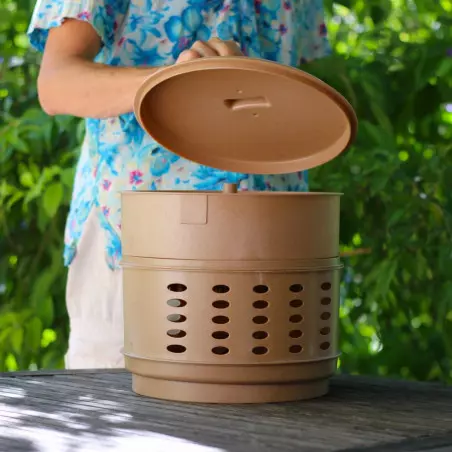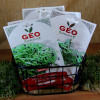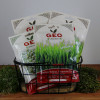Why Eat Sprouted Foods?
- Germination is a form of externalized digestion. By providing moisture and room temperature, humans recreate the spring conditions that allow the plant to grow and develop its full potential.
- Thanks to proteins that inhibit its enzymatic potential, the seed preserves itself through winter with this clever survival mechanism, allowing it to conserve its strength for the post-winter battle.
- Sprouted seeds are true micro-nutritional bombs. The more they sprout, the more vitamins and minerals they develop. They should be part of any respectable nutritional plan since no dietary supplement can match them!
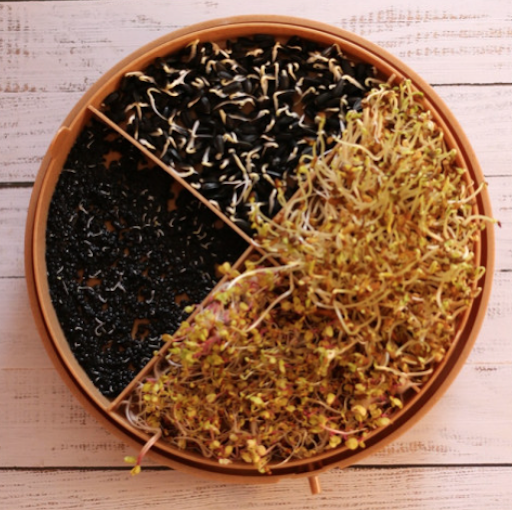
Enzymes:
- Among the plant kingdom, sprouted seeds are by far the primary source of enzymes. These enzymes are also used by our digestive system (lipases, proteases, amylases).
- It is important to know that enzymes are lost when plants are removed from the soil and when the temperature exceeds 45 degrees.
Example:
100 mg of peanut sprouted for 5 days = 42.3 mg of isocitritase, 69.4 mg of malate synthase
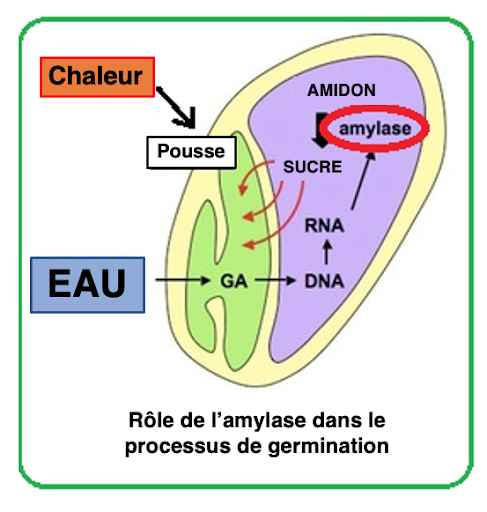
Vitamins:
They contain all the vitamins A, C, D, E, K and a whole cocktail of B vitamins.
Example:
10 g of soy sprouted for 2 days = 10.3 mg of vitamin C which is 2 times more than oranges
10 g of oat sprouted for 5 days =
115 mg of B1 which is 200 times more than lentils
91 mg of B2 which is 1300 times more than lentils
480 mg of B3 which is 2000 times more than lentils
18 mg of B5 which is 10 times more than lentils
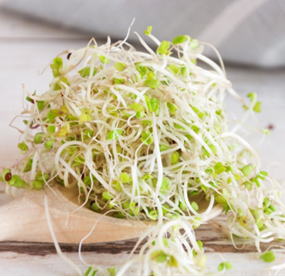
Minerals & Trace Elements:
Magnesium, potassium, calcium, sodium, iron, zinc, phosphorus, and sulfur.
Example:
10 g of Alfalfa sprouted for 3 days:
Magnesium: 31 mg which is 6 times more than spinach
Potassium: 200 mg which is 4 times more than spinach
Calcium: 175 mg which is 15 times more than milk
Iron: 3.5 mg which is 2 times more than lentils
Sulfur: 29 mg which is 2 times more than cabbage
Proteins & Fatty Acids
With a fairly well-distributed amino acid profile, sprouted seeds, when combined with nuts, will form a good amino acid. Remember that 100 grams of sprouted seeds represent two large handfuls, so combine 2, 3, or even 4 sources of protein depending on your digestive capacity.
Charles Poliquin, one of the best sports coaches in the world, always asked his athletes to optimize their protein intake by combining nuts.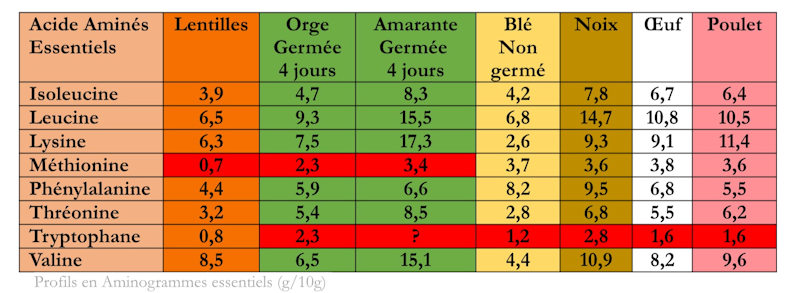
- Germinated Barley: DOI: 10.4236/as.2015.62020
- Amaranth: Article: Nutritional and Phenolic Profile of Early and Late Harvested Amaranth Leaves Grown Under Cultivated Conditions
- Chicken: DOI: 10.5851/kosfa.2014.34.5.709
But why are sprouted seeds rich in protein?
- Because they contain a lot of chlorophyll, and what we often forget is that chlorophyll is composed of amino acids.
- For the record, the 1915 Nobel Prize in Chemistry, Dr. Richard Martin Willstätter, discovered that human hemoglobin and chlorophyll have almost similar structures.
- The difference is that:
- Chlorophyll is built around a magnesium atom
- Blood heme is built around an iron atom.
- And paradoxically, a good number of studies show that increasing foods rich in chlorophyll helps to increase ferritin stores.
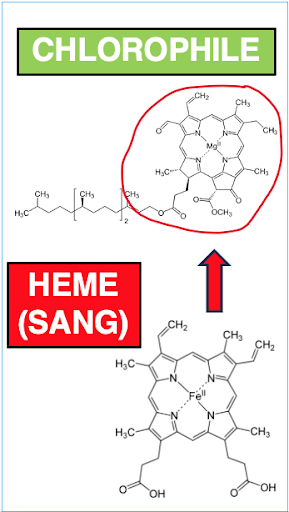
Example:
3-day sprouted Alfalfa:
3% fatty acids, 20% protein with a very balanced amino acid profile
25% fiber which is 18 times more than green salad
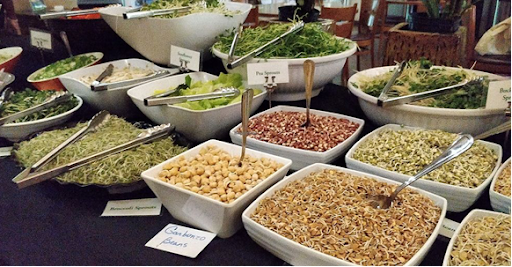
The buffet at the Hippocrates Health Institute, Florida... When I think of my frozen steak and fries from high school...
16 SPROUTS UNDER THE MICROSCOPE:
| Sprouts | Micro-nutritional interest | Sources and references |
| Alfalfa (lucerne) | Good source of vitamins A, C, D, B1, B2, B3, E, K, calcium, magnesium, potassium, iron, zinc, selenium, chlorophyll, fiber, protein. | Rebuild Your Health with Living Foods, 2nd edition (2005), Diane Perron and Ann Wigmore, pp. 279-283, 301 |
| Contains calcium, folic acid, magnesium, manganese, molybdenum, phosphorus, potassium, silicon, sodium, and zinc. The only plant that provides the full range of vitamins, from vitamin A, B complex (even B12), C, E to K. Sprouts placed in indirect sunlight for a few days before harvest produce nutritious chlorophyll that heals the blood. Best source of antioxidants among all vegetables. | Chef Sara Raw, Vegan, Gluten Free Cuisine (2011), Chef Sara Siso, p. 220 | |
| Amaranth | High levels of rare amino acids such as lysine or methionine. | Anna Maria Clement and Chef Kelly Serbonich, p. 121 Living Cuisine for Optimal Health, second edition (2007) |
| Contains the highest level of amino acids of all other seeds or grains. Good source of calcium, iron, protein, methionine, cysteine, fiber, magnesium, folate, potassium, phosphorus, and vitamins A, C, and E. Also contains two natural compounds, tocotrienols and phytosterols, known to help the body eliminate bad cholesterol. | Chef Sara Raw, Vegan, Gluten Free Cuisine (2011), Chef Sara Siso, p. 220 | |
| Basil | Vitamins A, C, and K Rich in iron, calcium, and omega-3 | |
| Beet | Helps in the production of red blood cells, aids digestion, aphrodisiac, helps in the creation of sex hormones. | Life Transformation Program (2017), Hippocrates Health Institute, p. 51 |
| Broccoli | Good source of vitamins A, C, minerals, and trace elements. | Rebuild Your Health with Living Foods, 2nd edition (2005), Diane Perron and Ann Wigmore, p. 306 |
| Effective for inflammations and swellings, effective for hangovers. | Life Transformation Program (2017), Hippocrates Health Institute, p. 51 | |
| Contains Chlorophyll and antioxidants, helping to regulate stomach acidity. Vitamins: C, K, B as well as phosphorus and magnesium. | Chef Sara Raw, Vegan, Gluten Free Cuisine (2011), Chef Sara Siso, p. 224 | |
| -Contains sulforaphanes and indoles, which have significant anticancer effects. -Scientists have discovered that sulforaphane stimulates the body's detox enzymes, is a powerful inducer of liver detoxification enzymes, and may also offer special protection to people with colon cancer. -Studies have shown that broccoli sprouts reduced tumor weight by 42% and optimized our cells' ability to disarm and eliminate free radicals and toxins. Researchers estimate that broccoli sprouts contain 10 to 100 times the potency of mature broccoli in stimulating enzymes that detoxify potential carcinogens. | ||
| Red Cabbage | Source of vitamins A, C, iodine, sulfur, chlorophyll. Rich in SMM, a sulfur-containing and water-soluble amino acid easily synthesized: S Methyl methionine (SMM). SMM is capable of relieving ulcers, especially those caused by the Helicobacter Pylori bacteria. Rich in calcium and sulfur. Contains iron, magnesium, phosphorus, calcium, sulfur, copper, and zinc. Vitamins: A, B1, B2, B3, C, and K. Great depurative, protects and repairs digestive mucous membranes. Hypoglycemic and vitalogenic. Rich in calcium and sulfur. Contains iron, magnesium, phosphorus, calcium, sulfur, copper, and zinc. Vitamins: A, B1, B2, B3, C, and K. Great depurative, protects and repairs digestive mucous membranes. Hypoglycemic and vitalogenic. -Anti-inflammatory, -Superb detox tool. | Rebuild Your Health with Living Foods, 2nd edition (2005), Diane Perron and Ann Wigmore, p. 279-280, 283, 302 Sprout Germ Life Transformation Program (2017), Hippocrates Health Institute, p. 52 |
| Cilantro | Good source of vitamin K Very low in calories Positive impact on cholesterol levels | Passeport santé: Vitamin K is necessary for blood clotting |
| Cilantro contains several antioxidant compounds: phenolic acids, coumarins, terpenoids, and flavonoids. | ||
| Fresh cilantro leaves contain carotenoids, including beta-carotene. For comparison, 125 ml of fresh cilantro contains almost as much beta-carotene as 250 ml of broccoli. | Canadian Nutrient File | |
| Kale (curly cabbage) ```html | Good source of vitamin A, C, minerals, and trace elements. | Rebuild Your Health with Living Foods, 2nd edition (2005), Diane Perron and Ann Wigmore, p. 306 |
| Corn | Source of thiamine (B1), riboflavin (B2), niacin (B3), biotin (H) | Rebuild Your Health with Living Foods, 2nd edition (2005), Diane Perron and Ann Wigmore, p. 348 |
| Oriental Mustard | Good source of vitamin A, C, minerals, and trace elements. | Rebuild Your Health with Living Foods, 2nd edition (2005), Diane Perron and Ann Wigmore, p. 279, 306 |
| Barley | Source of thiamine (B1), riboflavin (B2), niacin (B3), biotin (H) | Rebuild Your Health with Living Foods, 2nd edition (2005), Diane Perron and Ann Wigmore, p. 348 |
| Yellow Pea | Good source of vitamin A, C, H, B12, iron, potassium, magnesium, proteins, carbohydrates, fibers. | Rebuild Your Health with Living Foods, 2nd edition (2005), Diane Perron and Ann Wigmore, p. 279, 304, 348 |
| Source of proteins, helps muscles, strengthens teeth, stimulates the immune system. | Life Transformation Program (2017), Hippocrates Health Institute, p.53 | |
| Green Pea | Good source of vitamin A, C, H, B12, iron, potassium, magnesium, chlorophyll, proteins, carbohydrates, fibers. | Rebuild Your Health with Living Foods, 2nd edition (2005), Diane Perron and Ann Wigmore, p. 279, 282, 304, 348 |
| Protein 20-25%, good source of fiber and carbohydrates, calcium, iron, phosphorus, potassium. Vitamins: A, B, C, and E. Ability to lower blood sugar levels and reduce cholesterol. | Sprouted Germ Life Transformation Program (2017), Hippocrates Health Institute, p. 53 | |
| Red Radish | Good source of vitamin A, C, minerals and trace elements, chlorophyll. | Diane Perron and Ann Wigmore, p. 283, 306 |
| Cleans the blood, excellent expectorant for whooping cough, aids digestion. | Life Transformation Program (2017), Hippocrates Health Institute, p. 53 | |
| Buckwheat | High level of rutin (an antioxidant very good for the circulatory system). Has mucilaginous properties, gentle on the digestive system. | Living Cuisine for Optimal Health, second edition (2007), Dr. Anna Maria Clement and Chef Kelly Serbonich, p. 126 |
| Rich in minerals (phosphorus, potassium, magnesium, calcium, sulfur, sodium, chlorine) Rich in vitamins B1, B2, B3, B5, B6, and P (rutin), lecithin. Cleans the liver and arteries; rich in chlorophyll. Cerebral vascular | Sprouted Germ | |
| Source of proteins -Promotes lowering of blood pressure, balances blood sugar -Promotes prevention of osteoporosis. | Life Transformation Program (2017), Hippocrates Health Institute, p. 51 | |
| Sunflower | Good source of thiamine (B1), riboflavin (B2), niacin (B3), vitamin E, D calcium, iron, phosphorus, potassium, magnesium, chlorophyll, proteins, fats, amino acids. | Rebuild Your Health with Living Foods, 2nd edition (2005), Diane Perron and Ann Wigmore, p. 280-283, 306, 349-350 |
| Excellent source of amino acids with a balanced amino acid profile. Protein 23% Rich in fiber. Lowers blood pressure, facilitates intestinal transit ``` | Life Transformation Program (2017), Hippocrates Health Institute, p. 54 | |
| Complete food containing an abundance of chlorophyll, polyunsaturated fatty acids, potassium, phosphorus, magnesium, calcium, iron, and vitamins: B1, B3, B6, B12, D, E. | Sprouted germ |
Attention, during your germination process:
- Always thoroughly clean your sprouter after each use.
- Make sure to follow the watering instructions properly.
- Be careful, not all sprouted seeds are edible. Do not consume sprouted seeds from tomato, eggplant, pepper, yellow soy, and rhubarb.
- If in doubt, due to appearance or smell, throw everything away and disinfect your sprouter with white vinegar.
SO, NO MORE EXCUSES
BIOVIE French leader in the world of sprouted seeds, invites you to discover the 1st LOW TECH autonomous sprouter
The advantages:
- No need for electricity, works by gravity.
- Just add water to the reservoir and there's nothing else to do.
- High production. I tested it with sprouted barley, it's amazing.
- 100% ethical, made of cellulose and chalk, zero plastic.
- Very practical format (perfect for my Parisian apartment).
- 100% Made in France, packaging done by an ESAT.
Sources:
- Nutritional values of sprouts and wheatgrass Viktoras Kulvinskas
- https://instituthippocrates.com/
François Benavente, Naturopath



